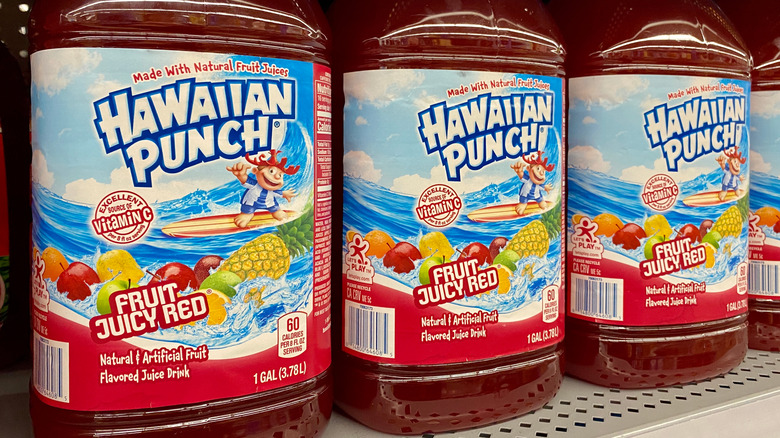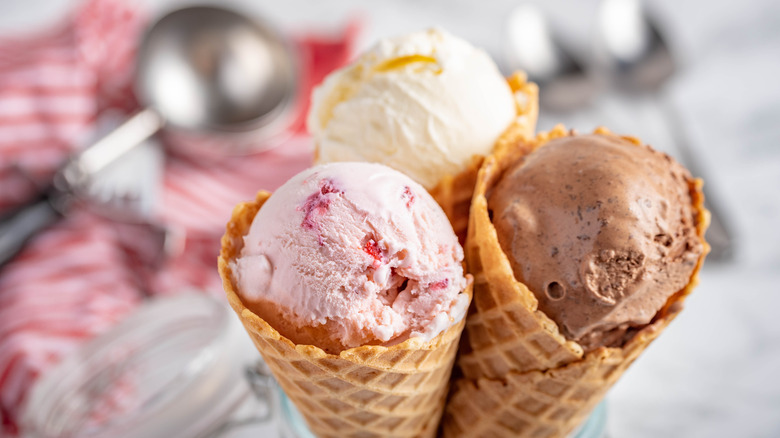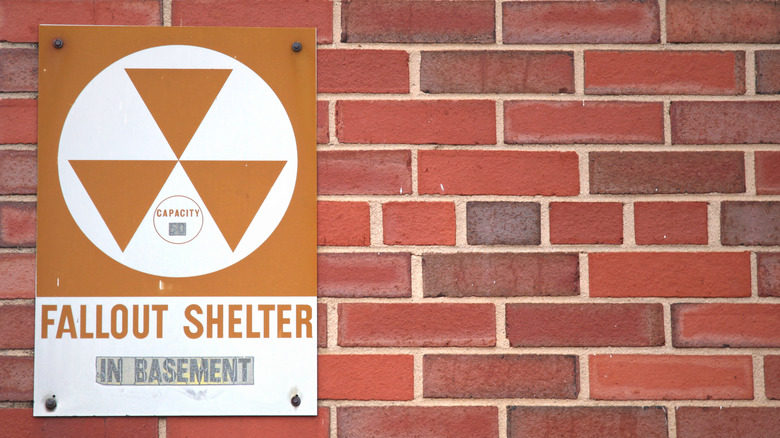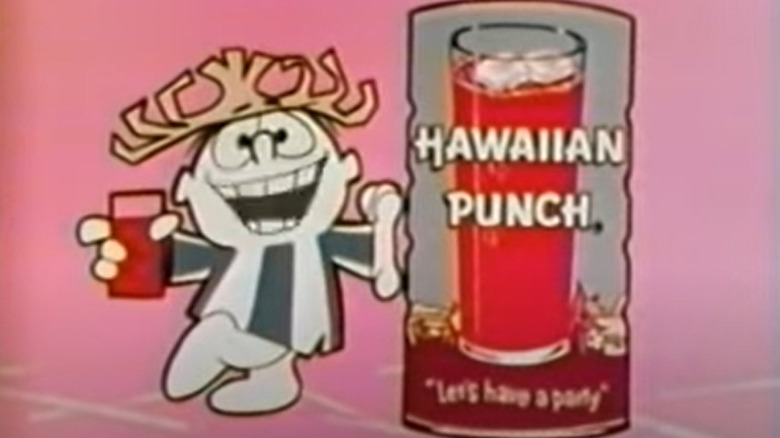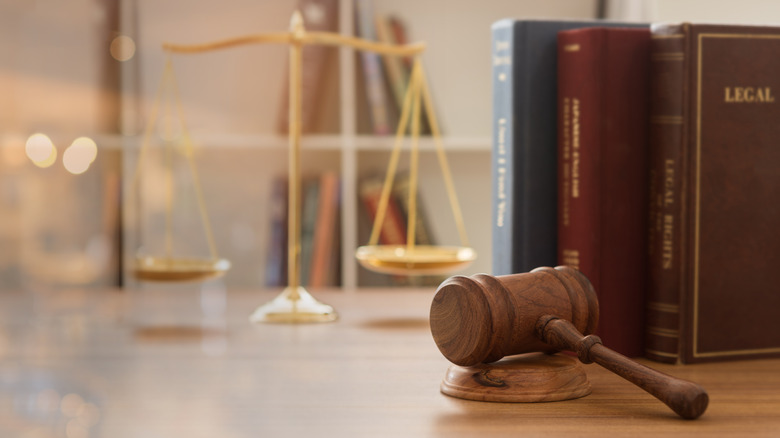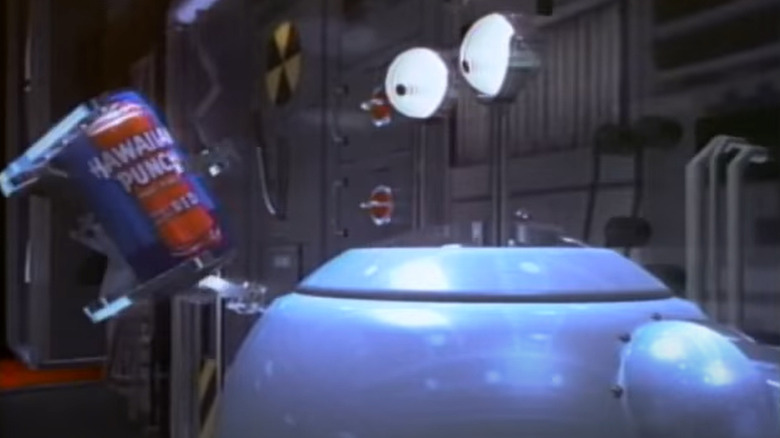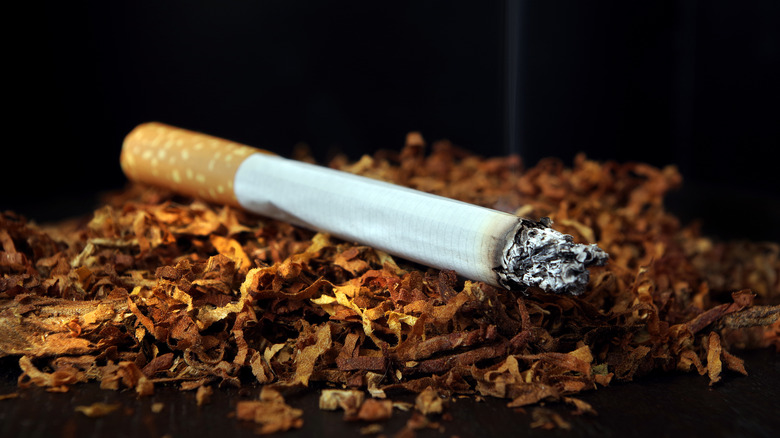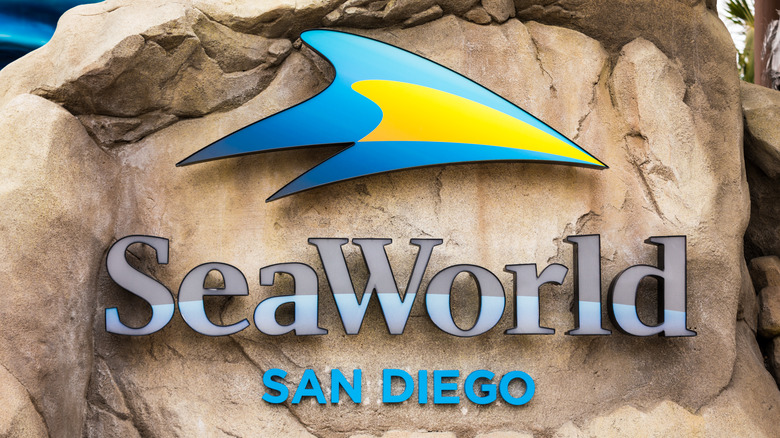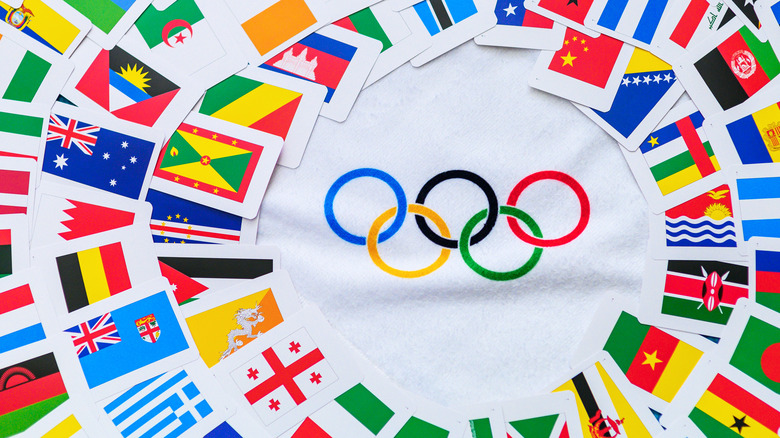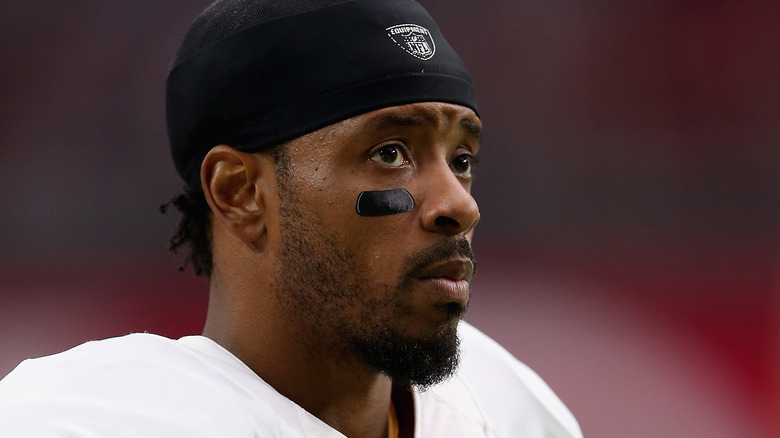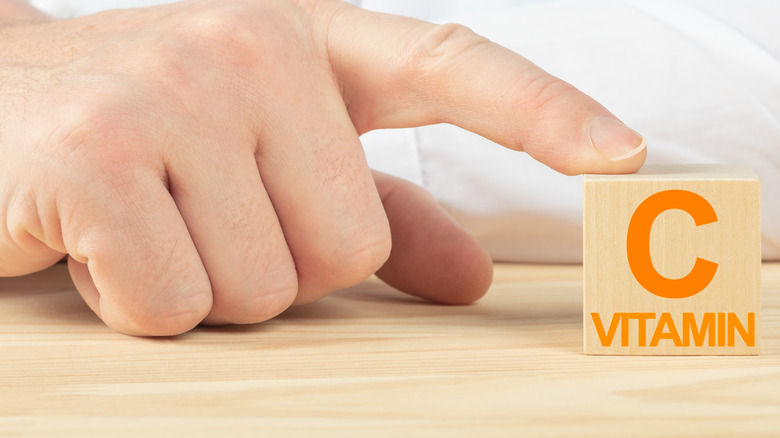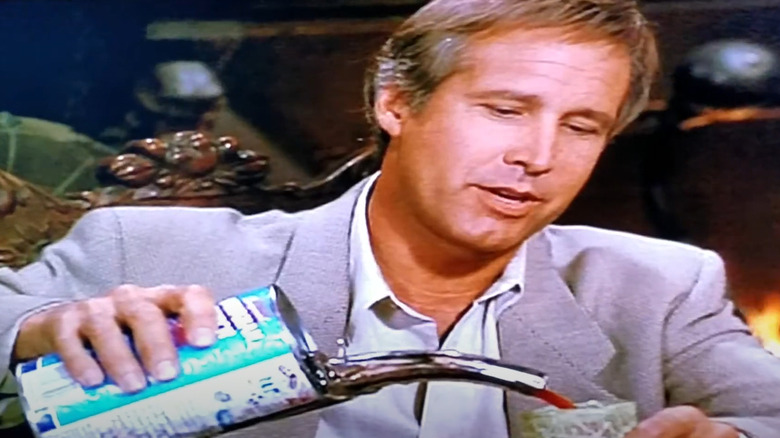The Untold Truth Of Hawaiian Punch
Hawaiian Punch: This bright red drink with a name that invokes beautiful tropical islands and celebrations has carved out its own identity in the beverage aisle.
Although Hawaiian Punch is best known today as a beverage for children, according to The Guardian, the drink was marketed to adults as a cocktail mixer before its manufacturer changed strategies. Since then, it's expanded from its original red, and you can now buy many different Hawaiian Punch flavors in a variety of bright colors. But this is only one small element of this children's juice drink's journey.
Over the course of its existence, Hawaiian Punch has been referenced by political and sports figures, as well as celebrities. And as The Guardian points out, its share of the marketplace expanded far beyond supermarkets and even food products. But what might be the most unexpected part of this drink's story is that despite having the word "punch" in its name, Hawaiian Punch was not concocted to be a drink for adults or children.
Hawaiian Punch started as an ice cream topping
While Hawaiian Punch is a drink today, that wasn't the original reason the product was created. According to Hawaiian Punch's website, when Ralph Harrison, A.W. Leo, and Tom Yates came up with "Leo's Hawaiian Punch" in 1934, it wasn't a beverage, but rather a syrupy ice cream topping sold by the Pacific Citrus Products Company. Although they made the original version of Hawaiian Punch in a garage in California, they had key ingredients for their ice cream topping sent to them from Hawaii.
In 1946, the Pacific Citrus Products Company changed hands and was renamed Pacific Hawaiian Products Co. When one of the investors, Reuben P. Hughes, learned that customers wanted to purchase "Leo's Hawaiian Punch" concentrate to mix with water and drink, he changed how the product was marketed. Up until this point, only businesses like ice cream manufacturers and restaurants purchased "Leo's Hawaiian Punch." Because of Hughes, Hawaiian Punch concentrate in quart bottles and a ready-to-serve version in 46-oz. cans became available to the general public.
While Hawaiian Punch saw great success in the 1950s, the brand changed hands again in 1963. This time, the R.J. Reynolds Company purchased Hawaiian Punch, and in 1981 put it in the hands of its subsidiary Del Monte. Other companies like Procter & Gamble Co. and Cadbury Schweppes have also owned the Hawaiian Punch brand. Currently, Dr. Pepper Snapple Group, Inc. owns Hawaiian Punch.
Hawaiian Punch was a staple of 1950s fallout shelters
Nowadays, basements are usually places for storing seasoning items like gardening tools or holiday decorations. However, as History.com explains, in the 1950s, basements were one possible location for fallout shelters in case of a nuclear attack. During this time the United States and the former Soviet Union were in the midst of a cold war. So, supplies, including Hawaiian Punch, became not just shopping list items, but also government-recommended survival essentials.
The Federal Civil Defense Administration (FCDA), which was created by the government in 1955, started "Grandma's Pantry," an initiative that advised families to have a week's worth of food and water in case of a nuclear attack (via History.com). Why "Grandma's Pantry"? Well, as the slogan for the initiative said, "Grandma was always ready for an emergency." According to Eater, stores had exhibits urging families to purchase Hawaiian Punch, as well as other non-perishables like Tang, candy bars, Campbell's soup, and cornflakes for their own personal "Grandma's Pantry." Besides these exhibits, magazine articles and radio ads also encouraged stockpiling food in case the worst should happen.
Its mascot was a hit even with The Tonight Show's host
Of course, it's impossible to talk about Hawaiian Punch without mentioning its iconic mascot, Punchy. As Pop Icon explains, the straw hat-wearing Punchy was created in 1961 and first appeared on television in 1962. However, the modern-day version of Punchy is notably different from his early counterpart.
The first Hawaiian Punch commercial with Punchy is only around 20 seconds. Despite this, both Punchy and his unwitting victim (a Hawaiian shirt-sporting man referred to as either Opie or Oaf), left an impression on audiences that endured for decades. The commercial starts with Punchy walking/leaping along happily while carrying a glass of Hawaiian Punch. He seemingly offers some to Opie with the phrase "Hey, how about a nice Hawaiian Punch?" When Opie replies "sure," Punchy instead sucker punches him in the face and walks away as if nothing happened. The Hawaiian Punch commercial was such an instant hit that the host of "The Tonight Show" at that time, Jack Parr, said "Let's play that again ... The second time is free."
Although the Punchy/Opie formula continued for decades (with Punchy running for president in 1992), the current Hawaiian Punch website only features Punchy — and a very different looking Punchy at that. According to Pop Icon, in 2003, the 3D version of Punchy replaced the original and remains Hawaiian Punch's mascot.
Its manufacturer sued the makers of Punch n' Fruity
Sometimes there's a fine line between a product that is similar to another product and a product that is a blatant ripoff of something else. This was the subject of a lawsuit in the late '70s between the R.J. Reynolds Company, which was making Hawaiian Punch at the time, and a fellow beverage manufacturer, per Time.
White Rock launched a beverage called Punch 'n Fruity, according to Time. R.J. Reynolds brought a lawsuit against White Rock, claiming that the packaging for Punch 'n Fruity looked too much like the packaging for Hawaiian Punch. Although a New York federal court found in favor of White Rock, R.J. Reynolds appealed the ruling in 1979 (via Casemine). The decision noted that R.J. Reynolds had spent around $36 million to advertise Hawaiian Punch in the two years before the trial. Efforts like this supported that Hawaiian Punch had established a visual recognition in the marketplace, and the court found that Punch 'n Fruity's can's design was too similar to Hawaiian Punch's and caused notable customer confusion. In part because of this, R.J. Reynolds' appeal was successful.
Although White Rock still exists today, its website's products do not include Punch 'n Fruity. In fact, none of its current beverages have the word "punch" in their names.
DEVO's cofounder helped create an electro pop ad
Although Punchy was still popular in the 1980s, that doesn't mean he was in every commercial for Hawaiian Punch. In fact, the marketing for the product went in a very different direction in 1987 when a cofounder of the group DEVO wrote the music for a Hawaiian Punch commercial (via Retroist).
For anyone who might not have been around in the '80s, DEVO is the group behind such classics as "Whip It" and "Shout" (per DEVO's website). Although they've become synonymous with the 1980s, according to IMDb, DEVO's origin actually goes back to the '70s when Mark Mothersbaugh, Jerry Casale, and Bob Lewis first formed the group. After some noteworthy successes (including "Whip It" going platinum), DEVO took a five-year hiatus during which time Mothersbaugh began writing music for commercials, including for Hawaiian Punch.
The commercial starts in a computer-animated workshop where music that has a rhythmic clanging quality reminiscent of hammering metal plays in the background, per Retroist. Hawaiian Punch accidentally drips on a robot, sparking it to life. This starts a chain reaction and eventually an assembly line of humanoid-looking robots are given Hawaiian Punch. Soon, the commercial cuts back and forth between the robots dancing and live-actionable humans dancing at a concert. It concludes with a robotic voice saying, "Hawaiian Punch, it hits you in all the right places" while the humans and the robots wave Hawaiian Punch cans in the air.
Its advertising was influenced by tobacco marketing
Brand mascots and eye-catching colors have become so commonplace in the marketing for various food products for children that they're practically accepted as the norm. But according to EurekAlert, research conducted by the University of California San Francisco found this type of marketing has its origins in the tobacco industry.
The study involved information from tobacco industry documents that until recently had been kept secret. "Executives in the two largest U.S.-based tobacco companies had developed colors and flavors as additives for cigarettes and used them to build major children's beverage product lines, including Hawaiian Punch, Kool-Aid, Tang, and Capri Sun," said senior author Dr. Laura Schmidt. One of these tobacco companies was R.J. Reynolds, which bought the Hawaiian Punch brand in 1963. Even though Hawaiian Punch had been marketed as something for cocktails, the company changed that approach and began putting Punchy on merchandise for children like schoolbook covers, clothing, comics, and toys. This approach was so successful that the documents state Punchy evolved from a mascot to the "best salesman the beverage ever had."
Although R.J. Reynolds no longer owns Hawaiian Punch, Dr. Schmidt said, "Even after the tobacco companies sold these brands to food and beverage corporations, many of the product lines and marketing techniques designed to attract kids are still in use today."
Hawaiian Punch had a village at SeaWorld
When the aquatic theme park SeaWorld opened in San Diego in 1964, it was the first attraction of its kind (via The Atlantic). In the first few decades of the park's existence, visitors to SeaWorld could relax and cool off in the Hawaiian Punch Village.
According to Retroist, this now defunct area of SeaWorld featured Punchy's Hawaiian Punch Band, which consisted of animatronic versions of not only Punchy and Opie but also animals at SeaWorld. These included an ice skating penguin, an octopus, a dolphin, a walrus, and an orca. Besides the band, a costume mascot version of Punchy was in the village to meet and greet park guests. In addition, the village screened travel films of the South Pacific.
Of course, the Hawaiian Punch Village featured non-alcoholic drinks, including several varieties of Hawaiian Punch and two mixed drinks made using Hawaiian Punch Fruit Juicy Red and Hawaiian Punch Sunshine Orange respectively, per Retroist. The village also served kushiyaki, which according to The Spruce Eats is an umbrella term in Japanese cuisine for grilled and skewered dishes.
It raised money for the U.S. Olympic Team
Hawaiian Punch ran a campaign promising to donate proceeds from sales to help U.S. Olympic athletes for the 1972 Olympics in Munich, Germany, according to Retroist. While this might seem like someone in marketing's strategy to tie Hawaiian Punch to a major sporting event, as Sports Illustrated reported, the originator of this idea was actually the U.S. Olympic Committee (USOC).
Similar to how someone donating to a Kickstarter campaign gets a gift for their donation, companies like Hawaiian Punch were allowed to use the Olympics in their advertising if they donated a certain amount of money to the USOC. For example, a business could advertise themselves as a supplier to the U.S. Olympic team, as well as use the symbol of the Olympics in their ads, if they made a $30,000 donation.
Besides raising money for Olympic athletes, Hawaiian Punch ran a contest where the winner would fly to Germany to watch the Olympic games in person, per Retroist. And according to Sports Illustrated, Hawaiian Punch was able to do this because a business that donated $100,000 to the USOC was given permission to run this type of contest. In fact, the winner not only won a trip to the Olympics but could also take three people with them.
Hawaiian Punch was referenced by a struggling football team
Most of the time when someone thinks of Hawaiian Punch commercials, they focus on Punchy. After all, he's the one who typically delivers that surprising sucker punch to the long-suffering Opie. But for some football players, it's Opie, not Punchy that has a special significance.
Santana Moss played as a wide receiver for the Washington football team from 2005 to 2015 (via ESPN). Quarterback Robert Griffin III also played for the Washington team from 2012 to 2015 before joining the Cleveland Browns, according to ESPN. When Moss was asked in 2013 about the difficulty his team and in particular Griffin III were having completing plays, he brought up Opie, per ESPN. "It's like the Hawaiian Punch guy," he explained. "'You want a Hawaiian Punch?' `Sure.' He got punched in the face." Although Moss said the commercial was funny, he also said his coaches in high school referenced Opie by saying, "'We're not going to be the Hawaiian Punch guy.'"
In other words, Opie never learned no matter how many times Punchy tricked him. In fact, Opie is sometimes called Oaf likely because of his foolishness. And what Moss was observing was the other teams were doing what Opie didn't do with Punchy: learning what to expect from Griffin III and adjusting their strategy.
All flavors give you 20% of your DV of vitamin C
While most of us think of the original flavor of Hawaiian Punch (a.k.a. Fruit Juicy Red), the Hawaiian Punch website currently lists 13 different flavors of Hawaiian Punch — and only four of them are red. All 13 flavors contain 18 milligrams of vitamin C per 8 fluid ounces, which is 20% of the recommended amount of vitamin C one should consume daily.
According to Healthline, humans can't make vitamin C on our own, so we need to consume foods that contain it. In addition, since it's a water-soluble vitamin, we also can't store extra for when we need it. And we definitely need it. Vitamin C is crucial for your immune system to function properly. It also helps your body recover from wounds and aids in the absorption of iron, per the Office of Dietary Supplements. And it's an antioxidant, so it can help lower your chances of developing cardiovascular disease and cancer.
While drinking Hawaiian Punch will give you more vitamin C than a baked potato or a half a cup of spinach, you can get more than 100% of the daily recommend amount of vitamin C from ¾ of a cup of orange juice (via Office of Dietary Supplements). Although Hawaiian Punch Fruit Juicy Red light has one gram of total sugar, all of the other current flavors have between 10 to 15 grams, so there are definitely healthier ways of getting your vitamin C.
Hawaiian Punch has been in movies and games
Arguably one of the standout moments for Hawaiian Punch was a memorable scene in the Adam Sandler movie "Mr. Deeds." Sandler plays Longfellow Deeds who learns his uncle has left him $40 billion (via Sony Pictures). Deeds arrives at his uncle's mansion and approaches what he thinks is a personal water fountain. But when he tries it, he exclaims "That's Hawaiian Punch" to which the valet (played by John Turturro) states "He [Deeds' uncle] adored Hawaiian Punch."
Another film that also had a notable scene featuring the drink was "Nothing But Trouble" where Chris Thorne (Chevy Chase) is held with others against their wills by the sadistic Judge Alvin 'J.P' Valkenheiser (Dan Aykroyd), according to IMDb. During a dinner scene, Judge Valkenheiser asks, "How about a nice Hawaiian Punch?" and passes the can to Thorne who says, "You know, there's nothing better at the end of a long day on the road than a nice warm glass of Hawaiian Punch."
Besides movies, Hawaiian Punch has found its way into the gaming industry. As Board Game Geek notes, there was a Hawaiian Punch board game where the players would make their game pieces (pineapples) out of Play-Doh. Each player would be also given a small Punchy figurine to squash their opponents' pineapples. In addition, a Hawaiian Punch vending machine was featured in the "Jurassic Park: Operation Genesis" video game, according to Good Bad Marketing.
